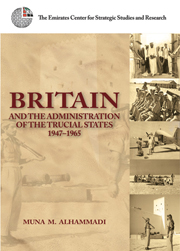Book contents
- Frontmatter
- Contents
- Abbreviations and Acronyms
- Preface
- Introduction
- 1 British Administration in the Trucial States before 1965
- 2 The Trucial Oman Levies and Scouts, 1951–1965
- 3 The Trucial States Council, 1952–1965
- 4 The British Role in the Development of the Trucial States before 1965
- Conclusion
- Notes
- Bibliography
- About the Author
- Index
2 - The Trucial Oman Levies and Scouts, 1951–1965
Published online by Cambridge University Press: 05 September 2014
- Frontmatter
- Contents
- Abbreviations and Acronyms
- Preface
- Introduction
- 1 British Administration in the Trucial States before 1965
- 2 The Trucial Oman Levies and Scouts, 1951–1965
- 3 The Trucial States Council, 1952–1965
- 4 The British Role in the Development of the Trucial States before 1965
- Conclusion
- Notes
- Bibliography
- About the Author
- Index
Summary
The key goal of British policy in the emirates from 1820 up to the independence of India in 1947 was to maintain maritime peace and security in the waters of the Gulf, it being one of the most important transit routes to India. Hence, the British were keen to avoid involvement in any domestic unrest, such as the wars that periodically broke out between tribes, provided they did not threaten the safety of maritime navigation.
However, the post-war period witnessed a radical transformation in this strategy, as British interests gradually grew to encompass the hinterland. This was a result both of the rising likelihood of major oil discoveries, and the new independence of India. The uncertain conditions in the emirates worried Britain, particularly at a time when diplomatic representation was only just developing, and oil companies were undertaking geological survey operations.
This state of instability owed much to the deteriorating economic conditions in the region. Rising unemployment resulted in various forms of disorder, including raids on farms, robberies of caravans and cars, and the growing popularity of arms smuggling operations that channeled weapons to Oman and Baluchistan. Britain was also concerned about the thriving trade in slaves in the region, including the abduction of women and children to be sold into slavery, particularly from Buraimi. This was a source of considerable embarrassment for Britain in international terms in light of its pioneering stance against slavery worldwide.
The most pressing security issue, however, was the recurring internal unrest caused by border disputes in the region, which occurred after oil exploration companies resumed their activities following the end of the war. These companies sought to determine the exact geographical range of the influence of each ruler in order to accurately determine the area covered by a concession.
- Type
- Chapter
- Information
- Publisher: Emirates Center for Strategic Studies and ResearchPrint publication year: 2013



